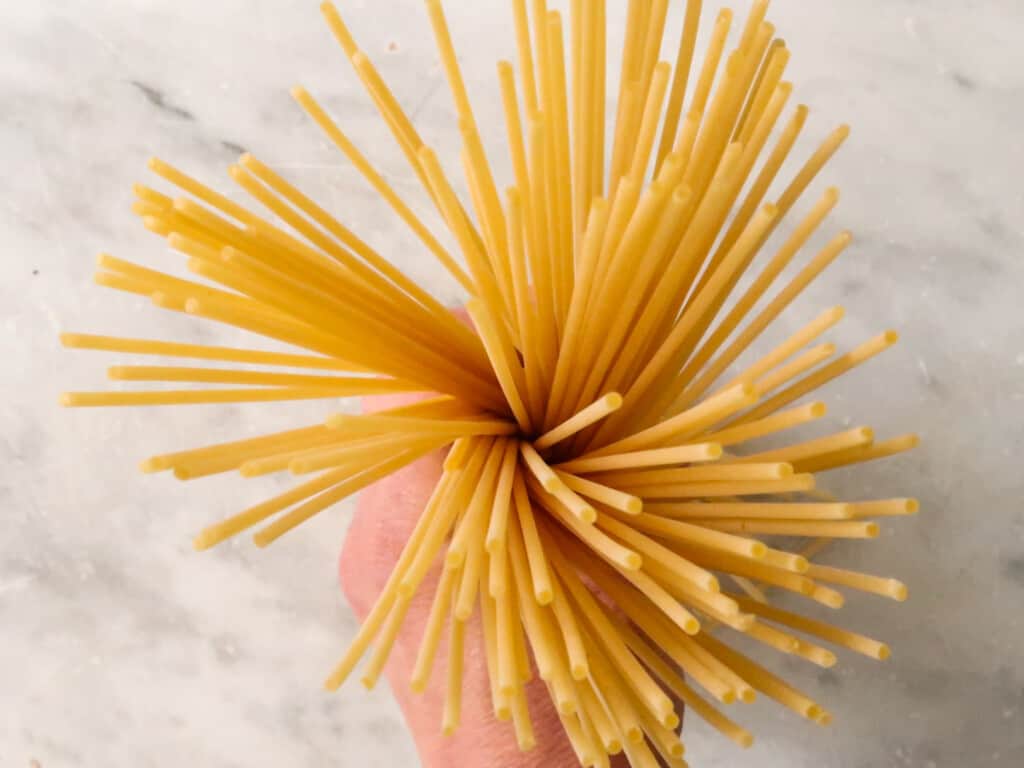Last updated on October 26th, 2023
Don’t you wish you could enjoy the flavor and fresh taste of summer basil year round, even in the dead of winter? Well you can! Freeze fresh basil in olive oil for year round summer flavor in the kitchen in no time with these easy methods.
There really is no better way to brighten up hearty winter cooking with a bit of freshness. I love to add a bit of frozen basil to a pot of hearty minestrone or slow-cooked tomato sauce – it instantly transports me to summer!
And frozen fresh basil is so much better than dried basil. Once you do it, you will never want to use the dried stuff again!
In this article, I will walk you through exactly how to freeze basil in olive oil, how to defrost it and how best to use it throughout the year.
Jump to Section
Reasons For Freezing Fresh Basil In Olive Oil
- Use the fresh flavor of summer basil 12 months a year
- Reduce your food waste by storing all excess summer basil
- Make fresh, homemade pesto out of season
- Brighten up slow-cooked meals such as tomato sauce even in the winter
Olive Oil For Freezing Basil Leaves

When choosing an olive oil for breezing basil leaves, use whatever is affordable and accessible to you. In this case, it’s not important that the olive oil is extra virgin. You don’t want to use other oils such as canola or peanut. Stick to a good, everyday olive oil that will improve the taste of any dish you add it to.
If you want to use extra-virgin olive oil, even better!
Learn More: For more information about olive oil recommendations, read 15 Best Italian Olive Oils – To Enjoy in Italy & Bring Home as a Souvenir and Best Italian Olive Oil Brands in America – Where to Buy Them and How to Store Them. And check out How to Store Olive Oil.
How To Blanch Basil Leaves
Blanching is the process of quickly cooking a fresh vegetable or other green to preserve the color. Blanching is always followed by an ice bath to ‘shock’ the vegetables or whatever is being blanched to stop the cooking process.
It’s important to blanch basil before freezing it if you want to preserve its bright green color. If you don’t blanch it, the leaves will turn brown or black. This will not compromise the flavor.
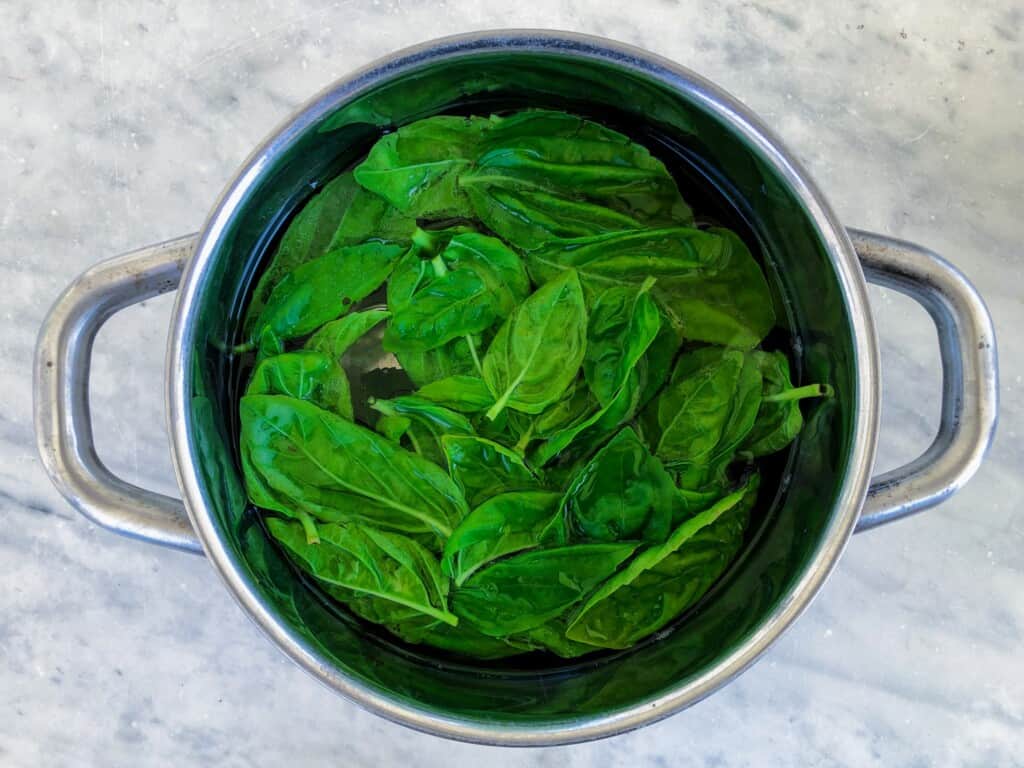
To blanch basil, fill a large pot of water with water and bring to a boil. Add the basil leaves and cook for about 10 seconds.
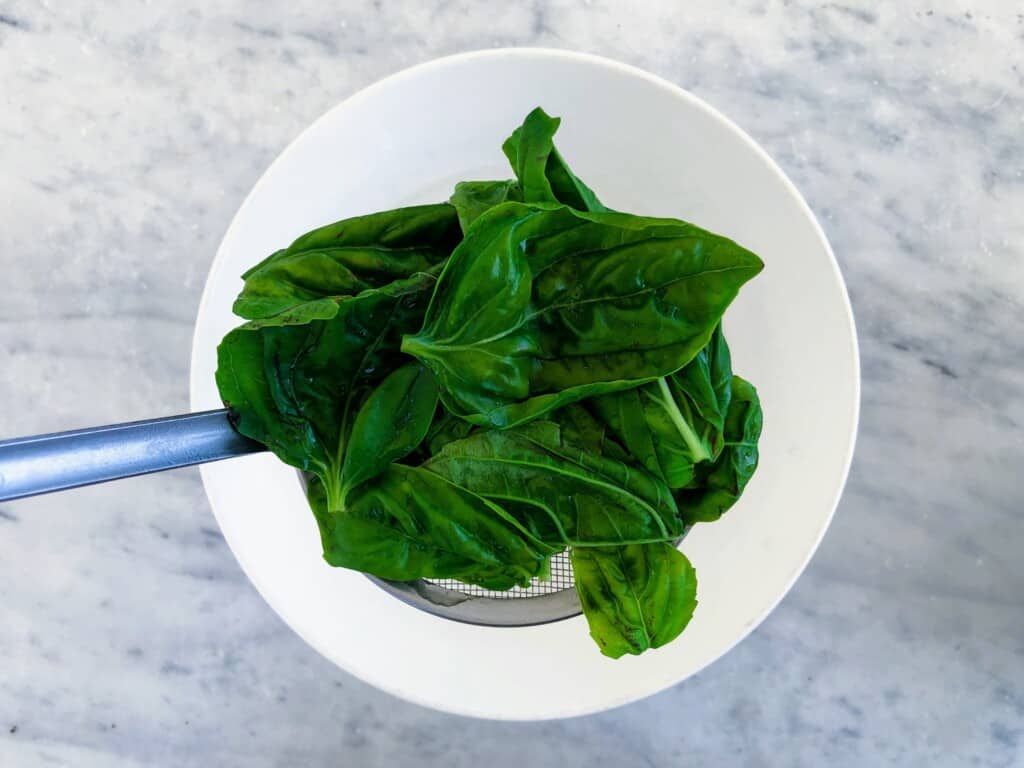
Transfer the basil leaves to an ice water bath to stop the cooking process. Drain well and dry either with a salad spinner or pat dry with a towel.

Freezing Basil Leaves In Olive Oil
You can either keep the leaves whole, chop them and/or blanch them to preserve the bright green color before freezing basil in olive oil. The decision is a personal preference but my preferred method is to always blanch the basil before freezing it in olive oil.

Good To Know: Basil always turns black when it’s frozen without being blanched. If the color is important to you, always blanch your basil before freezing it. Blanching can be done for any method that you choose listed in this article. It’s just a matter of whether or not you have the time and will to do so.
Freezing Basil In Olive Oil With A Food Processor
Best For: When you want to prep ahead to make cooking easier later on.
Freezing basil in olive oil using a food processor is great for things like pesto and salad dressing when the basil should be chopped well anyhow. If you care about retaining the bright green color, blanch and dry the leaves before adding to the food processor.

Once the basil is cleaned, make sure all the stems are removed and add to the food processor. Add just a drizzle of olive oil at a time (about a tablespoon) just until the basil is chopped well but not yet pureed into a smooth paste.

Scoop the mixture into ice cube trays and freeze. You can then transfer the basil olive oil cubes to a ziplock bag and pull out one by one or as needed. Store for about six months.
Freezing Hand Chopped Basil In Olive Oil
You can freeze basil in olive oil with a similar method and result by chopping the basil by hand. The best way to chop basil is to chiffonade it or chop it into ribbons without bruising it.

To chiffonade basil, stack the basil leaves into a small pile and roll them into a small cigar shape. Using a sharp knife, cut firmly through the basil leaves into small strips or ribbons and gently pull them apart.

Transfer the basil ribbons to a bowl and add just enough olive oil to coat the basil. Scoop the basil oil mixture into ice cube trays and freeze.

Fact: Never try to mince or finely chop basil because it will bruise it, comprising the flavor, aroma and color. As a general rule, only cut once through the basil. Never cross-cut over already cut basil.
Alternatively, you can simply fill each ice cube tray with the cut basil leaves and drizzle olive oil directly into each ice cube section without mixing it together in a bowl first.
Freezing Fresh Basil Olive Oil
Best For: Freezing olive oil to later make pesto or other puréed sauces.
To make basil olive oil, it’s best to blanch the basil first (see above). Being sure all the stems and woody stocks are removed from the basil, put the leaves in a blender or food process. Add just enough olive oil to make a smooth, uniform paste. You can adjust the fluidity of your basil olive oil by adding more or less oil.

Scoop the mixture into ice cube trays and freeze. Transfer the basil olive oil cubes to a ziplock bag and keep for up to six months.
Other Ways To Freeze Basil Leaves
Flash Freeze Basil Leaves
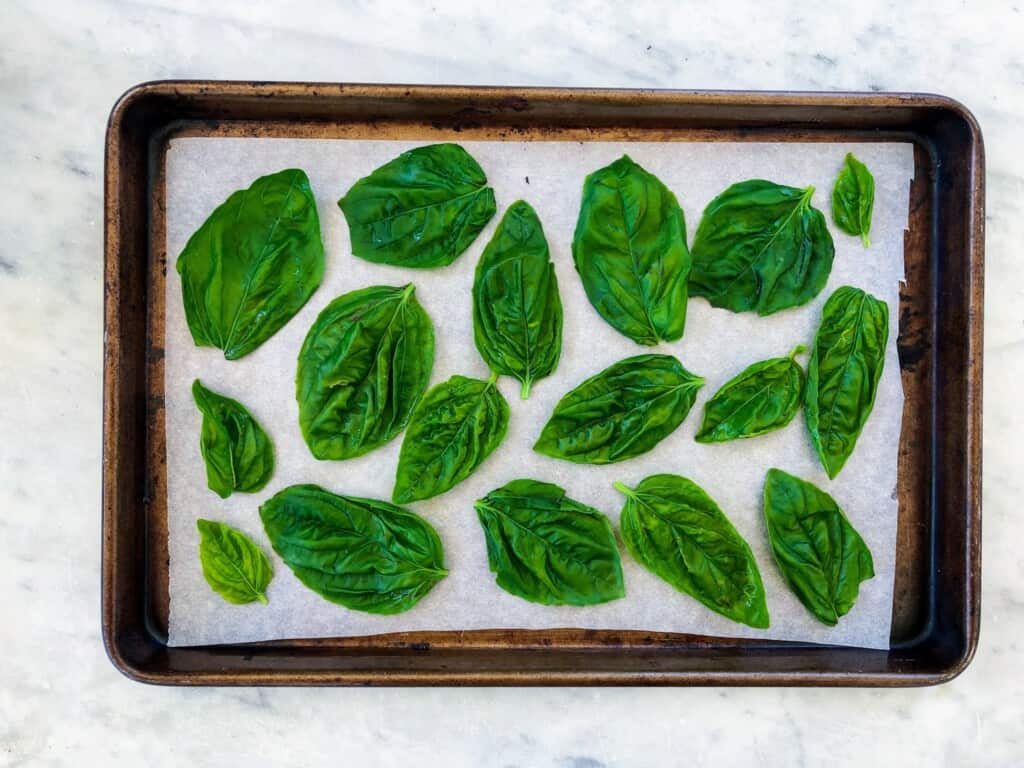
Best For: When you want a beautiful presentation using whole basil leaves.
Remove the basil leaves from the stems. Blanch the basil (see above).
Dry the leaves well in either a salad spinner or pat well with a paper towel or a cloth.
Spread the cleaned, dry basil leaves on a baking sheet lined with parchment paper and flash freeze for about 1 hour. Transfer the frozen basil leaves to freezer bags and use them as needed. Store for up to six months.
Wash And Freeze Basil Leaves
Best For: When you are crunched for time because there is no blanching involved. Use in dishes such as tomato sauce or pizza sauce in which it will not matter if the leaves are discolored.
Remove the basil leaves from the stems and gently wash them. Spin them dry in a salad spinner or pat them dry with a towel.

Fact: In this method, the basil leaves will turn brown or black, which is okay if you are adding them to cooked sauces.
Spread the cleaned basil leaves on a baking sheet lined with parchment paper and flash freeze for about 1 hour. Transfer the frozen basil leaves to freezer bags and store for up to six months.
How To Thaw Frozen Fresh Basil

Basil that has been frozen in olive oil can be thawed in a bowl covered with plastic wrap on the countertop. You can pull it out the night before, place it in a small bowl and thaw it more slowly in the refrigerator to be used the next day.
You can also use the frozen fresh basil as is and pop it directly into your dishes that you are cooking without defrosting beforehand. For example, pop a couple of cubes into a pot of freshly prepared tomato sauce. The residual heat will slowly thaw the basil and cook it just enough to release all its aroma and flavor.

Tip: If you’re planning to use your basil in heated dishes, add your frozen basil directly to the pot. There’s no need to thaw it first.
How To Use Frozen Fresh Basil
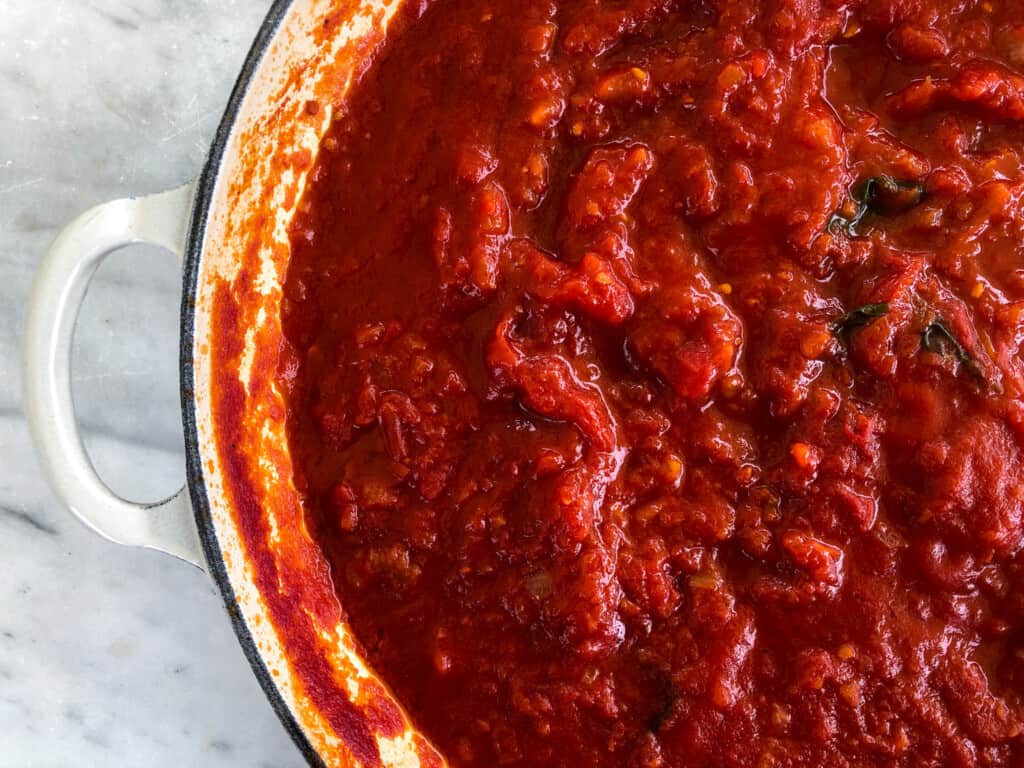
Frozen basil that has been preserved in olive oil can be used in any dish in which you are adding olive oil. If you are cooking the basil, you can add the cubes directly to the heat which will defrost the frozen basil leaves. If, however, you are using them raw such as in a salad or in pesto, simply defrost them beforehand in a covered dish either in the refrigerator or at room temperature.
Popular dishes to used basil preserved in olive oil:
- tomato sauce
- fresh tomato sauce
- pizza sauce (or sauce for pinsa)
- pesto
- salad dressings
- panzanella
- pappa al pomodoro
- bruschetta
How to Freeze Fresh Basil in Olive Oil – Chopped Basil Method
Materials
- basil
- olive oil
Instructions
- Clean the basil, removing stems and blanch it in a large pot of boiling water for 10 seconds. Shock in an ice bath (a bowl filled with cold water and ice cubes) until cold.
- Drain and dry well either in a salad spinner or with a towel.
- Chiffonade the basil by stacking the leaves, rolling them in a cigar shape and slicing with a sharp knife into ¼ inch ribbons.
- Place the basil into individual ice cube tray cells and cover with just enough oil to cover the basil leaves.
- Transfer to the freezer and allow the basil cubes to freeze completely.
- Once frozen, remove the basil olive oil cubes from the ice cube tray and transfer to a freezer ziplock bag.
- Label and store the basil cubes in the freezer for up to six months.
How to Freeze Fresh Basil in Olive Oil – Pureed Basil Method
Materials
- basil
- olive oil
Instructions
- Clean the basil, removing stems and blanch it in a large pot of boiling water for 10 seconds. Shock in an ice bath (a bowl filled with cold water and ice cubes) until cold.
- Drain and dry well either in a salad spinner or with a towel.
- Add the clean, dry basil leaves to the food processor. Pulse and add just enough olive oil to create a smooth paste. For a more fluid paste, add a bit more oil.
- Spoon the prepared basil olive oil mixture into ice cube trays.
- Transfer to the freezer and allow the basil olive oil cubes to freeze completely.
- Once frozen, remove the basil olive oil cubes from the ice cube tray and transfer to a freezer ziplock bag.
- Label and store the basil cubes in the freezer for up to six months.
Freezing Basil in Olive Oil FAQ
No, fresh basil can be added straight to olive oil and frozen but it will turn black. If you want to preserve its bright green color then simply blanch it before freezing.
You can freeze basil with any herbs you like, including parsley. The proportions are up to you and the process will be the same as freezing just basil. If you plan on using a woody herb such as rosemary or thyme, remove the twigs before freezing.
No, you can use whatever olive oil is accessible for you. Extra virgin has the best flavor but using another grade will not compromise the flavor of the frozen basil.
The best and easiest way to freeze basil is to chiffonade the basil, put it into ice cube trays and cover it with olive oil. Pull it out at any time for a kick of summer flavor. If you wish to preserve the bright green flavor of olive oil, blanch it beforehand.
It’s much better to freeze basil than to dry it because the flavor profile does not change. When you dry basil, the fresh flavor and color changes fairly quickly.
In my experience, frozen basil will last for up to six months in the freezer if stored properly in a freezer ziplock bag.





